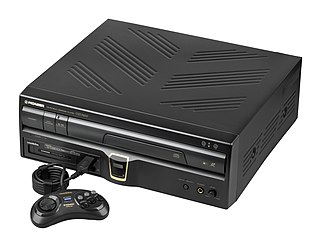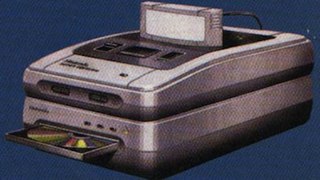
The PlayStation is a home video game console developed and marketed by Sony Computer Entertainment. It was released in Japan on 3 December 1994, in North America on 9 September 1995, in Europe on 29 September 1995, and in Australia on 15 November 1995. As a fifth-generation console, the PlayStation primarily competed with the Nintendo 64 and the Sega Saturn.

The Sega CD, known as Mega-CD in most regions outside North America and Brazil, is a CD-ROM accessory and format for the Sega Genesis produced by Sega as part of the fourth generation of video game consoles. Originally released in November 1991, it came to North America in late 1992, and the rest of the world in 1993. The Sega CD plays CD-based games and adds hardware functionality such as a faster CPU and a custom graphics chip for enhanced sprite scaling and rotation. It can also play audio CDs and CD+G discs.

The Dreamcast is the final home video game console manufactured by Sega. It was released on November 27, 1998, in Japan; September 9, 1999, in North America; and October 14, 1999, in Europe. It was the first sixth-generation video game console, preceding Sony's PlayStation 2, Nintendo's GameCube, and Microsoft's Xbox. The Dreamcast's 2001 discontinuation ended Sega's 18 years in the console market.

Bleem! is a commercial PlayStation emulator released by the Bleem! Company in 1999 for IBM-compatible PCs using Microsoft Windows and the Dreamcast. It is notable for being one of the few commercial software emulators to be aggressively marketed during the emulated console's lifetime, and was the center of multiple controversial lawsuits.
Full-motion video (FMV) is a video game narration technique that relies upon pre-recorded video files to display action in the game. While many games feature FMVs as a way to present information during cutscenes, games that are primarily presented through FMVs are referred to as full-motion video games or interactive movies.

The Visual Memory Unit (VMU), also referred to as the Visual Memory System (VMS) in Japan and Europe, is the primary memory card produced by Sega for the Dreamcast home video game console. The device features a monochrome liquid crystal display (LCD), multiplayer gaming capability, second screen functionality, a real-time clock, file manager, built-in flash memory, and sound capability. Prior to the launch of the Dreamcast, a special Godzilla edition VMU, preloaded with a virtual pet game, was released on July 30, 1998, in Japan.

The LaserActive is a converged device and fourth-generation home video game console capable of playing LaserDiscs, Compact Discs, console games, and LD-G karaoke discs. It was released by Pioneer Corporation in 1993. In addition to LaserActive games, separately sold add-on modules accept Mega Drive/Genesis and PC Engine/TurboGrafx-16 ROM cartridges and CD-ROMs.
Homebrew, when applied to video games, refers to software produced by hobbyists for proprietary video game consoles which are not intended to be user-programmable. The official documentation is often only available to licensed developers, and these systems may use storage formats that make distribution difficult, such as ROM cartridges or encrypted CD-ROMs. Many consoles have hardware restrictions to prevent unauthorized development.

The GD-ROM is a proprietary optical disc format developed as a collaboration between Sega and Yamaha for the Dreamcast. A double-density format based on the CD-ROM that could hold up to 1 GB, it consists of a single-density track near the disc's center surrounded by a double-density track comprising much of the disc's capacity. The GD-ROM was created in response to developers exceeding the typical 650 MB storage capacity of the CD-ROM; while DVD-ROM would have addressed this limitation, implementing its then-new technology would have made console production cost prohibitive. Along with the format's general novelty, the extra capacity also had the theoretical benefit of curbing video game piracy, a major concern of CD-based consoles that was validated by its rampancy on the PlayStation.
Echelon is a warez group which specializes in the illegal release and distribution of copyrighted console games, such as Dreamcast and PlayStation 2 ISO images. They also created demos on both platforms.
Kalisto is a console warez group established in March 1998, a subsidiary of Fairlight, which specializes in the release and distribution of PlayStation (PS1) and PlayStation 2 (PS2) ISO images, briefly moonlighting on the Dreamcast platform in mid to late 2000.
The double-density compact disc (DDCD) is an optical disc technology developed by Sony and Philips using the same 780 nm laser wavelength as a compact disc. The format was announced in July 2000 and is defined by the Purple Book standard document. Unlike the compact-disc technology it is based on, DDCD was designed exclusively for data, with no audio capabilities.
A mixed mode CD is a compact disc which contains both data and audio in one session. Typically the first track is a data track while the rest are audio tracks. The most common use for mixed mode CDs is to add CD-quality audio to video games on a CD.

The Official Dreamcast Magazine was a video game magazine for the Dreamcast video game console published in the United States. It was published by Imagine Media.

The Dreamcast VGA Box is an accessory for the Dreamcast, a video game console produced by Sega, that allows it to output to a computer monitor or a high-definition television (HDTV) set through a VGA connector in 480p, otherwise known as progressive scan. The Dreamcast was one of the first consoles to support 480p and HDTV in general. Sega released the VGA Box as an official accessory in Japan on January 14, 1999, at an MSRP of ¥7000; it was only available in the United States via Sega's online store, retailing between $30 and $50. Though the VGA Box did not receive a release in Europe, PAL consoles can use it since it has no regional lockout.

The Super NES CD-ROM is an unreleased add-on for the Super Nintendo Entertainment System (SNES) video game console. It was built upon the functionality of the cartridge-based SNES by adding support for a CD-ROM-based format known as Super Disc.









